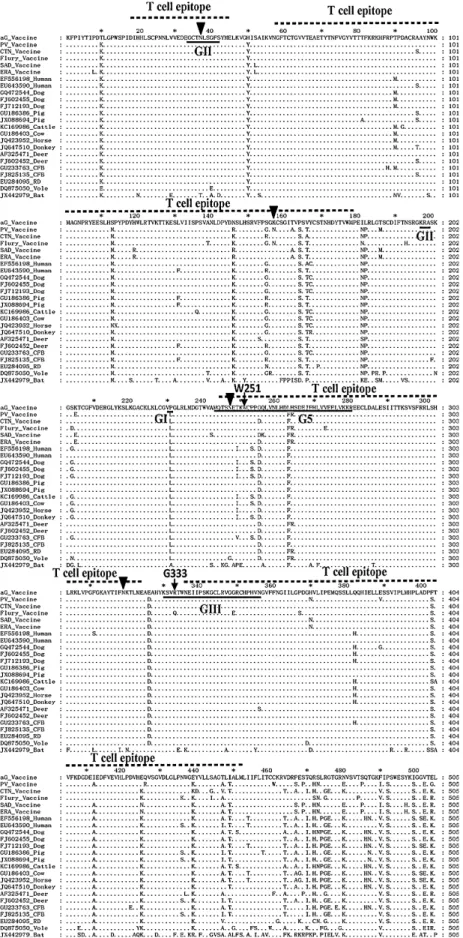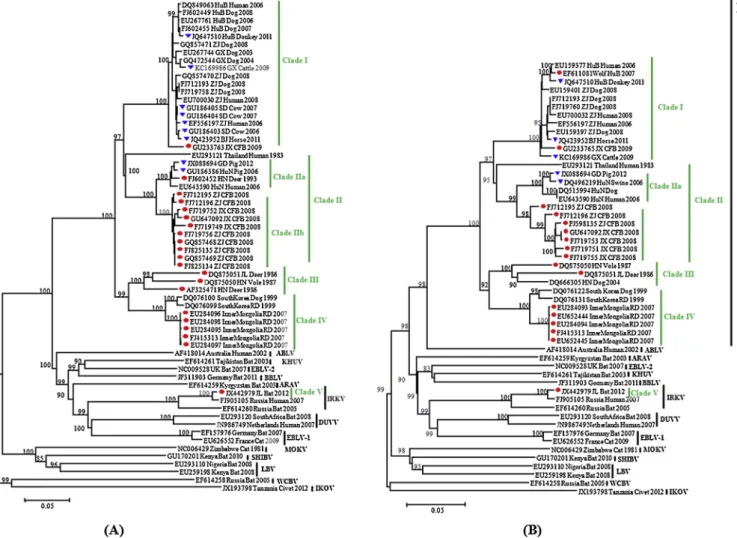Review
Rabies
and
rabies
virus
in
wildlife
in
mainland
China,
1990–2013
Lihua
Wang
a,b,*
,
Qing
Tang
a,b,
Guodong
Liang
a,baStateKeyLaboratoryforInfectiousDiseasePreventionandControl,KeyLaboratoryforMedicalVirology,NationalInstituteforViralDiseaseControland Prevention,ChineseCenterforDiseaseControlandPrevention,155ChangbaiSt.,ChangpingDist.,Beijing102206,China
bCollaborativeInnovationCenterforDiagnosisandTreatmentofInfectiousDiseases,Hangzhou,China
1. Introduction
Rabiesisoneoftheoldestdiseasesinrecordedhumanhistory, datingbackmorethan4000years.1Itoccursinover150countries and territories.2 More than 70000 human rabiesdeaths occur
annually, and Asia accounts for approximately 80% of the worldwidetotal.3Rabieswasfirstreportedinabout556BCand haspersistedinChinaformorethan2500years.Rabieshasbeen oneofthemostimportantinfectiousdiseasesinChinasincethe 1950s.4,5Althoughcomprehensivepreventivemeasureshavebeen
taken in past decades (including dog vaccination and post-exposureprophylaxisfollowinghumanexposure),rabiesremains a significant public health problem in mainland China.4–7
Currently,ChinaissecondonlytoIndiainthenumberofpeople killedbyrabiesworldwide,andtheepidemicareahasexpandedto almosttheentirecountry.Manyprovincesarebeginningtoreport theirfirstcasesinmorethan10years.5–8
TheroleofthedomesticdoginthespreadofRABVshasbeen establishedinChina,andalmost95%ofhumancaseshavebeen associated with dog transmission.5–9 However, the number of
wildliferabiesandwildlife-associatedhumanandlivestockrabies caseshasincreasedinrecentyears,particularlyinthesoutheast andnortheastregionsofChina(Figure1andTable1).Themajority haveoccurredinthemostrecent10years.Viruseshavealsobeen isolatedordetected inwildlife,includingthebat,Chineseferret badger,raccoondog,Apodemus,deer,vole,andwolf.10–20Tobetter understand wildlife rabiesand its role in humanand livestock rabies,wereviewedwhatisknownaboutwildliferabiesfromthe 1990s to 2013 in mainland China. Additionally, the genetic diversity and phylogeny of available wildlife-originated RABVs wereanalyzed.
2. SpeciesofwildlifecarryingrabiesinmainlandChina
Anywarm-bloodedanimalcancatchrabiesandpassrabiesto human beings.3 Dogs are themain vectors of rabies and have
played a pivotal role in human rabies in mainland China.5–9
Howeverrabieshasalsobeenreportedinwildlifeandlivestock
ARTICLE INFO Articlehistory: Received6March2014
Receivedinrevisedform17April2014 Accepted17April2014
CorrespondingEditor:EskildPetersen, Aarhus,Denmark Keywords: Wildliferabies Geneticdiversity Phylogeny MainlandChina SUMMARY
Thenumberofwildliferabiesandwildlife-associatedhumanandlivestockrabiescaseshasincreasedin
recentyears,particularlyinthesoutheastandnortheastregionsofmainlandChina.Tobetterunderstand
wildliferabiesanditsroleinhumanandlivestockrabies,wereviewedwhatisknownaboutwildlife
rabiesfromthe1990sto2013inmainlandChina.Inaddition,thegeneticdiversityandphylogenyof
availablewildlife-originatedrabiesviruses(RABVs)wereanalyzed.Severalwildlifespeciescarryrabies
includingthebat,Chineseferretbadger,raccoondog,rat,fox,andwolf.RABVshavebeenisolatedor
detectedinthebat,Chineseferretbadger,raccoondog,Apodemus,deer,andvole.Amongthem,thebat,
Chineseferretbadger,andraccoondogmayplayaroleintheecologyoflyssavirusesinmainlandChina.
Allwildlife-originatedRABVswerefoundtobelongtogenotype1RABVexceptforabat-originatedIrkut
virusisolatedin2012.Severalsubstitutionswerefoundbetweentheglycoproteinofwildlife-originated
RABVsand vaccinestrains. Whetherthesesubstitutionscouldaffecttheefficacy ofcurrentlyused
vaccinesagainstinfectionscausedbythesewildlife-originatedRABVsneedstobeinvestigatedfurther.
PhylogeneticanalysisshowedthatRABVsinthebat,Chineseferretbadger,andraccoondogweredistinct
fromlocaldog-originatedRABVs,andalmostallcollectedwildlife-originatedisolateswereassociated
witholderChinacladesIItoV,suggestingthepossibilityofwildlifereservoirsinmainlandChinathrough
theages.
ß2014TheAuthors.PublishedbyElsevierLtdonbehalfofInternationalSocietyforInfectiousDiseases.
ThisisanopenaccessarticleundertheCCBY-NC-NDlicense(
http://creativecommons.org/licenses/by-nc-nd/3.0/).
* Correspondingauthor.Tel.:+861058900896;fax:+861058900840. E-mailaddress:wanglih9755@hotmail.com(L.Wang).
ContentslistsavailableatScienceDirect
International
Journal
of
Infectious
Diseases
j o urn a l hom e pa ge : ww w. e l s e v i e r. c om/ l o ca t e / i j i d
http://dx.doi.org/10.1016/j.ijid.2014.04.016
1201-9712/ß2014TheAuthors.PublishedbyElsevierLtdonbehalfofInternationalSocietyforInfectiousDiseases.ThisisanopenaccessarticleundertheCCBY-NC-ND license(http://creativecommons.org/licenses/by-nc-nd/3.0/).
includingtheChineseferretbadger,raccoondog,bat,Apodemus, deer,vole,fox,wolf,cat,pig,yellowbull,goat,sheep,cattle,buffalo, anddonkey.Casesofwildliferabieshaveoccurredinbothrabies endemic areas (southeast) and sporadic areas (northeast) of mainlandChina(Figure1,Table1).
2.1. Chineseferretbadger
Asoneof themostpopular wildlifeanimals,Chineseferret badgers (Melogale moschata) are distributed mostly in the southeastregionofChina.5,11Since1995,Chineseferretbadger
rabiesoutbreakshaveoccurredperiodicallyinthesoutheastof mainlandChina, includingtheprovincesof Anhui,Jiangxi,and Zhejiang.20RABVswerefirstdetectedinChineseferretbadgers
collected in Zhejiang Province in 2008, and have since been detected continuously in Chinese ferret badgers (alive and dead) collected in Anhui, Jiangxi, and Zhejiang provinces (Figure 1, Table 1).12,19,20 Nucleotide sequencing revealed
99.4–99.8%homologywithintheChineseferretbadgerisolates, and 83–89% homology to the dog RABV isolates in the nucleoprotein and glycoprotein genes in the same rabies-endemic regions.12,19,20 Inaddition, one study showed
appar-entlyhealthyChineseferretbadgerswithahighpercentageof rabies seroconversion (69.6%). Although the titration of virus neutralizingantibodies(VNA)wasverylow,rangingfrom 0to 2.6 IU/ml, the high percentage of rabies seroconversion in Chineseferretbadgersisaninterestingdiscovery,andcouldbe dueto abortive rabies infectionsin the Chinese ferretbadger population.20
2.2. Raccoondog
InmainlandChina,raccoondogsaredistributedwidelyinthe northeastern and southwestern regions of rabies-endemic areas.14,21Twooutbreaksofraccoondograbieshavebeenrecorded
in mainland China.One occurredin thecounty of Qingyuan of Liaoning Province in 1982, causing more than 30 raccoon dog deaths.13 The otheroccurred in Inner Mongoliain 2007.14 The
latter outbreak was caused by one wild raccoon dog, and 15 domesticraccoondogsdied.Therabidanimalshadtypicalclinical signsofrabies,andsamplestestedpositivebydirectfluorescence assay (DFA), reverse transcription polymerase chain reaction (RT-PCR),and mouseinoculationtest (MIT).Geneticanalysisof the isolatedvirusshowed that theoutbreak wascaused by an arctic-likeRABV.14Thiswasthefirstreportofarctic-likeRABVin
China. 2.3. Bat
Otherthancarnivores,thebatisthemostimportantnatural reservoirhostofRABVs knowntoday.22In recentyears,several
researchgroupshaveconductedlong-termstudiestoinvestigate whether bats carry rabies in mainland China; RABVantibodies weredetected intheserumof collectedbats.Ofthebat serum samplescollectedfromfoursouthernprovinces(Yunnan,Guangxi, Guangdong, and Hainan) ofChina in 2010,2.2% (15/685)were positive for RABV antibodies.23 However, no bat-originated
lyssavirus was isolated until 2012: the first bat-originated lyssavirus (Irkut virus, IRKV-THChina12; in Murina leucogaster) Figure1.DistributionofwildlifeandlivestockrabiesreportedinmainlandChinafromthe1990sto2013.Speciesofwildlifeandlivestockreportedtocarryrabiesare indicatednexttothenameofeachprovince.Provinces:AH,Anhui;BJ,Beijing;CQ,Chongqing;FJ,Fujian;HA,Henan;HB,Hebei;HI,Hainan;HLJ,Heilongjiang;HuB,Hubei; HuN,Hunan;GD,Guangdong;GS,Gansu;GX,Guangxi;GZ,Guizhou;JL,Jilin;JS,Jiangsu;JX,Jiangxi;LN,Liaoning;NM,InnerMongolia;NX,Ningxia;QH,Qinghai;SC,Sichuan; SD,Shandong;SH,Shanghai;SN,Shaanxi;SX,Shanxi;TJ,Tianjin;XJ,Xingjiang;XZ,Tibet;YN,Yunnan;ZJ,Zhejiang.CFB,Chineseferretbadger;RD,raccoondog.
wasisolatedandidentifiedinJilinProvince(northeastregionof China).10 The nucleoprotein gene of IRKV-THChina12 shared 92.4%/98.9%(nucleotide) and92.2%/98.8% (amino acid)identity with the two known Irkut virus isolates from Russia. The identificationofIRKV-THChina12representsthefirstisolationof abatRABVinmainlandChina.10Thelatterfindingconfirmedthe
existenceofbatRABVsin commonChinesebatspecies,andwe believe that additional bat RABV species will be identified in mainlandChinawithmoreextensivesurveillance.
2.4. Rat
Rabies-carryingrats have beenidentified in Chinasince the 1990s. The first rat-originated lyssavirus, MRV (Mouse Rabies virus),was isolatedfroma volecollected in Henan Provincein 1992.24Phylogeneticanalysisbasedonthewholegenomeshowed
MRVtobedistinctfromlocaldog-originatedRABVs.17Inaddition,
65ratscapturedinGuangxiProvincein2000showed3.1%(2/65) positivity forRABV byRT-PCR.25RABVs werealso identifiedin
Table1
Summaryofreportedwildliferabiesandwildlife-associatedhumanrabiesinmainlandChina,1990–2013 Provinces Countiesa
Period Rabiescases Number tested Confirmationmethodb Ref. Chineseferret badgerrabies ZJ Lishui 2008 1 23 DFA/RT-PCR 19 JX Fuzhou 2009 1 23 DFA/MIT/RT-PCR 12 ZJ,AH,JX /c 2010 9 265 FAT/MIT 20
Batrabies GX Nanning,Bobai 2000 3 320 RT-PCR/MIT 25
GX Nanning,Ningming 2005–2006 6 268 IFAT/FAVN 23
HI Boao 2005–2006 2 183 IFAT/FAVN 23
GD Yangchun 2005–2006 7 207 IFAT/FAVN 23
JL Tonghua 2012 1 261 DFA/RT-PCR/MIT 10
Ratrabies HA Nanyang 1987 3 97 ELISA/MIT/RT-PCR 17,24
GX Nanning 2000 2 65 RT-PCR/MIT 25
ZJ Lishui 2008 1 57 DFA/RT-PCR 15
Wolfrabies NM Jalaite 1991 2 Clinicaldiagnosisandepidemiological
investigation
26
Foxrabies NM ALaShanZuoQi 1999 1 Clinicaldiagnosisandepidemiological
investigation
27
Raccoondograbies LN Qingyuan 1982 1 1 MIT/clinicaldiagnosis 13
NM Zhengxiangbaiqi 2007 15 5 DFA/MIT/RT-PCR/clinicaldiagnosis 14
Chineseferret badger-originated humanrabies
ZJ Huzhou 1994 7 Clinicaldiagnosisandepidemiological
investigation
37
ZJ Changxing 1994–1995 6 Clinicaldiagnosisandepidemiological
investigation 20 ZJ Lin’an,Chun’an, Tonglu,Jiande, Quzhou,Huzhou, Changxing
1996–2004 29 Clinicaldiagnosisandepidemiological investigation
38
ZJ Coteau 2002–2004 7 Clinicaldiagnosisandepidemiological
investigation
39
ZJ Hangzhou 2006–2007 2 Clinicaldiagnosisandepidemiological
investigation
20
ZJ QingTian,Lishui 2008 2 Clinicaldiagnosisandepidemiological
investigation
20,26 AH Xuancheng,Shexian,
Huangshan,Jingxian
2002–2005 29 Clinicaldiagnosisandepidemiological investigation
20
JX Wuyuan 2007–2008 4 Clinicaldiagnosisandepidemiological
investigation
20
SC Yaan 2004 1 Clinicaldiagnosisandepidemiological
investigation
41 Bat-originated
humanrabies
JL Tonghua 2002 1 Clinicaldiagnosisandepidemiological
investigation
9
JL Longjing 2010 1 Clinicaldiagnosisandepidemiological
investigation
10 Rat-originated
humanrabies
SC Santai 1989 2 Clinicaldiagnosisandepidemiological
investigation
45
ZJ Taizhou 1981–2003 1 Clinicaldiagnosisandepidemiological
investigation
47
JS Binhai 1991 1 Clinicaldiagnosisandepidemiological
investigation
46 Wolf-originated
humanrabies
NM Jalaite 1991 6 Clinicaldiagnosisandepidemiological
investigation
26
XJ Tacheng 1996 1 Clinicaldiagnosisandepidemiological
investigation
18 a
AH,Anhui;GD,Guangdong;GX,Guangxi;HA,Henan;HI,Hainan;JL,Jilin;JS,Jiangsu;JX,Jiangxi;LN,Liaoning;NM,InnerMongolia;SC,Sichuan;XJ,Xingjiang;ZJ, Zhejiang.
b DFA,directfluorescenceassay;RT-PCR,reversetranscriptionpolymerasechainreaction;MIT,mouseinoculationtest;FAT,fluorescentantibodytest;IFAT,indirect fluorescentantibodytest;FAVN,fluorescentantibodyvirusneutralizationtest;ELISA,enzyme-linkedimmunosorbentassay.
c
ApodemusagrariusinZhejiangProvincein2009.15Althoughthese
virusesweredistinctfromlocaldog-originatedRABVsbasedon phylogeneticanalysis, theybelongedtothe genotype1 RABVs. Rabiesin ratsisrather unusual,globally.Howeverin mainland China,particularlyin therabiesendemicareas, ratsare widely distributed, which increases the chance of contact with rabid animals. These cases of reported rat rabies would come from contactwithrabidanimals.
2.5. Rabiesinotherwildlifeandlivestock
Rabid foxes and wolves attacking livestock or humans and causingrabiesoutbreakshavebeenreportedinInnerMongoliaand XinjiangProvince,18,26,27indicating that the fox and wolfcarry
rabiesinmainland China.Cats, pigs, yellowbulls,goats, sheep, cattle,buffalo,anddonkeyshavealsobeenreportedtocarryrabies inmainlandChina.5,26–34Based onanalysisoftheepidemiology
andvirusesisolatedordetectedintheselivestock,thesecaseswere relatedtolocaldograbies.
3. Roleofwildlifeinhumananddomesticanimalrabiesin mainlandChina
3.1. Chineseferretbadger
AlthoughrabiesinChineseferretbadgershasbeenreportedin othercountries, Chinese ferretbadger-associated humanrabies hasbeenreported onlyinChina.20,35,36Humancasescausedby
rabid Chinese ferret badgers were first recorded in Huzhou, ZhejiangProvince in 1994.37Since then,Chinese ferret badger-associated human rabies has increased and is a public health concern in mainland China.From 1996 to2004,more than 30 human cases were caused by Chinese ferret badger bites in ZhejiangProvince.38,39From2004to2007,nohumanrabiescases
causedbyChineseferretbadgerbiteswerereportedintheseareas. In2008,Chineseferretbadger-relatedhumancasesreemergedin ZhejiangProvince:onehumancasewascausedbyinfectionafter captureandconsumptionofChineseferretbadgermeat.40Chinese
ferretbadger-associatedhumancaseshavealsobeenreportedin otherprovincesofChina.From2002to2005,sevenChineseferret badger-associatedhumancaseswerereportedinAnhuiProvince; in addition, from 2007 to 2008, four Chinese ferret badger-associated human cases were reported in Wuyuan, Jiangxi Province.20In2004,anindependentreportstatedthatapeasant
haddiedofrabiesafterbeingbittenbyaChineseferretbadgerin Yaan, Sichuan Province.41 The Chinese ferret badger-associated rabiespatientshaveincludedChineseferretbadgerhunterswho captureandsellChineseferretbadgers,farmerswithoccasional exposuretosickChineseferretbadgers,andresidentsexposedto sick Chinese ferret badgers in their yard or house. Currently, Chineseferretbadgertradingandtheconsumptionofitsmeatare commoninthesoutheastareasofChina,resultinginafrequent sourceofChineseferretbadgerbitesorcontactwithhumans.20
AwarenessthattheChineseferretbadgerisareservoirofRABVs could help people to protect themselves, particularly those residentinthesouthernpartofChina.
3.2. Raccoondog
Althoughtworaccoondograbiesoutbreakshavebeenrecorded inmainlandChinasince1982,nohumanrabiescausedbyarabid raccoondoghasbeenreported.13However,becauseraccoondogs havebeenconfirmedtocarryarctic-likeRABVinmainlandChina, raccoondogsshouldnotbeallowedcontactwithdomesticanimals orhumanbeings.13,14
3.3. Bat
Batshaveplayedanimportantroleinthetransmissionofrabies tootheranimalsandhumanbeingsthroughouttheAmericasand in Europe.42,43 The first bat-associated human rabies case in mainlandChina,reportedin2002,wasthatofastaffmemberata television broadcastingstationin TonghuaCounty in northeast JilinProvince.Thevictimsufferedbatbitestotheearanddied10 daysafterthefirstmanifestationofdiseasesymptoms.9In2010,
another bat-associated human rabies case was reported in LongjingCityinJinlinProvince. Thevictim sufferedbat bitesto thehand and died10 days following thefirst manifestation of disease symptoms.44 Both cases developed acute progressive
encephalomyelitisconsistentwithrabiesinfection,30and20days, respectively,afterthebites.Theseresultsindicatethatbatsposea threattohumanhealthinmainlandChina.
3.4. Ratrabies
Severalhumanrabiescaseswerereportedtohavebeencaused byratsinthehigh-epidemicrabiesareasofmainlandChinainthe 1990s.45–47 Thereafter, rat-originated human rabiescases were
rare.ConsideringthatRABVshavebeendetectedinratsandthat humanrabiescasescausedbyratshavebeenreported,andtaking intoaccountthefrequencyofhumancontactwithratsduetotheir wide distribution and high density in mainland China, we recommendthattheroleofratsintransmittingRABVstohumans and animals beevaluated,particularlyin rabies-endemicareas, eventhoughsomeexpertshavereportedthatratsdonothaveany epidemiologicalroleinthetransmissionofrabiestohumans. 3.5. Otherwildlife
Wolf-associatedhumanoranimalrabieshasbeenreportedin Chinasincethe1990s.In1991,twowolvesattacked31peopleand 127 domestic animals in Jalaite in Inner Mongolia,causing six human rabies cases and 19 domestic animal rabies cases.26
Thereafter, wolf-associated human and animal rabies were reportedsporadically.From1996to2006,severalwolf-associated human and animal rabies cases were reported in Xinjiang Province.18,48Todate,mostwolf-associatedrabiescasesreported in northeast China have usually been a spillover of dog rabies ratherthanatruecycleofwolfrabies.Accordingtothosereports, wolfrabiesmaynotbeathreattohumansinotherareas,including high-epidemic rabiesareasin thesoutheast andeast regionsof mainlandChina.
FoxesareamajorvectorofrabiesandareaRABVreservoirfor sylvaticrabiesinEurasiaandpartsoftheAmericas.49Wildfoxes
exist in the northwest, south, and northeast regions of China; additionally,foxesarebredforfurproductioninChina.5Although
rabidfoxesattackinggoatsandcausingrabiesoutbreakshasbeen reportedinInnerMongolia,foxrabiesandfox-associatedhuman and animal rabiesarerare inChina,probably due tothesmall numberofanimals,resultinginminimalcontactwithhumans.27
Accordingtotheliterature,theroleoffoxesintransmittingrabies infectiontohumansandotheranimalsisnegligibleinChina.
4. Geneticdiversityandevolutionarycharacteristicsof wildlife-originatedRABVsandrelationshiptodog-originated RABVsinmainlandChina
4.1. Geneticdiversityoftheglycoproteingeneinwildlife
Openreadingframes(ORFs)ofglycoprotein(G)genesofRABVs inwildlife,livestock,anddomesticanimalswere1575nucleotides in length, encoding a 524-amino acidpolyprotein, as reported
Figure2.MultiplealignmentofGproteinaminoacidresidues1–505forwildlife-,livestock-,anddog-originatedRABVsandvaccinestrainsusedinMainlandChina.Antigenic siteGI(aminoacid231),GII(aminoacids34–42and198–200),GIII(aminoacids330–338),andG5(aminoacids244–281)areunderlined.TrianglesindicatetheN-linked glycosylationsites.DottedlinesindicatetheT-cellepitopes.
previouslyforotherRABVsinChina.50,51ComparisonofRABVG
genes between wildlife and domestic animals (includingdogs) revealedputativeaminoacidsequenceidentitiesof87.2%to99.8%. TheGgeneofbat-originatedIRKV-THChina12wasfoundtoshare 66.9% to 71.6% amino acid identity with other wildlife- and domesticanimal-originatedRABVsinChina.UsingtheaGstrain (GenBank accession number GQ412744) as the reference se-quence,wealigned theavailableGgenesofwildlife-,domestic livestock-,and dog-originatedlyssaviruseswith humanvaccine strains(CTN,Flury,and PV)andveterinaryvaccinestrains(SAD andERA)inChina.Thehighlyvariableregionsarelocatedinthe transmembrane region (aminoacids 440–461) and cytoplasmic carboxy terminal domain (amino acids 462–505) (Figure 2). SeveralsubstitutionswerefoundinthelinearepitopeG5(amino acids253–275)ofwildlife-originatedlyssaviruses.52Amongthe T-cellepitopes,53aminoacids103–178,244–291,and336–452were
more variable in wildlife and domestic livestock-originated Chinese lyssaviruses. In addition, the bat-originated IRKV-THChina12 showed considerably lower conservation in all of theseantigenicsites andepitopes.Whetherthesesubstitutions wouldaffecttheantigenicpropertiesofthesewildlife-originated RABVs,aswellastheefficacyofcurrentlyusedvaccinesagainst thesewildlife-originatedRABVinfections,shouldbeinvestigated further.
4.2. Wildlife-originatedRABVsarealmostexclusivelyisolatedwith olderlineages
The G and N gene sequences of all available lyssaviruses carried by wildlife and domestic animals (including dogs) in mainland China, together with corresponding sequences from representative lyssaviruses, were aligned and subjected to phylogeneticanalysis.TheG(Figure3A)andN(Figure3B)gene phylogenetictreesshowedsimilartopologystructure.Allofthe wildlife-originatedlyssavirusesweregroupedwithintheclassic RABV,withtheexceptionofthebat-originatedIRKV-THChina12. Thewildlife-originatedlyssavirusesweredistributedacrossfive majorsub-clades(designatedcladesI–V).Asreported previous-ly,cladeIisarelativelyrecentlineagethatisgainingdominance and is now responsible for most of the new rabies cases in mainland China.50,51,54–57ThesamplesincladeIwereisolated
almostexclusivelyfromdogs,withalmostalloftheremaining samplescollectedfromhumansanddomesticatedanimals.Only twosampleswereisolatedfromwildlife(Chineseferret badger-originated JX09-17 and wolf-originated hubei070308). Con-versely, for the older clades (clade II to clade V), a larger proportion of isolateswere collectedfromwildlife,suggesting theexistence ofwildlifereservoirsin mainlandChina through theages.
Figure3.Neighbor-joiningphylogenetictree(P-distance)for(A)theGgene,and(B)theNgeneofRABVsisolatedfromwildlife,livestock,anddogsinmainlandChina.GandN genesequencesoflyssavirusesisolatedfromwildlife,livestock,anddogsinmainlandChinaweredownloadedfromGenBankandcombinedwithrepresentativestrainsof lyssavirusestoformthedatasetusedinthisstudy.AlignmentofnucleotidesequenceswasperformedusingClustalXsoftware,version2.1.59
Phylogeneticandevolutionary analyseswereconductedusingMEGA,version3.1.60Bootstrapanalysiswasperformedusing1000replications,andvaluesgreaterthan70%wereregardedasstrongevidence
fortheparticularphylogeneticgroupings.Numbersindicatethebootstrapvaluesfrom1000replicates.CladesI–Vareindicated.Reddotsindicateisolatesfromwildlife.Blue trianglesindicateisolatesfromlivestock.
4.3. Therelationshipbetweendog-andwildlife-originated lyssavirusesinmainlandChina
In mainland China, the dog plays a pivotal role in rabies transmission,andapproximately95%ofhumanrabiescasesare ascribedtodogbites.5–9Thephylogeneticanalysisshowedthe
isolatesfromdogsanddog-associatedhumancasestobegrouped mainlywithinthe relativelyrecent lineage(clade I).Onlyone Chineseferretbadger-originatedstrainandonewolf-originated strainisolated recentlyhave been identified within the China clade I, which suggests that the incidence of wildlife rabies spillover from domestic dogs has been emerging in China recently. Other RABVs from Chinese ferret badgers, raccoon dogs, and bats were segregated into independent lineages (Figure 3) and were distinct from dog- and other domestic animal-originated isolates. The latter finding indicates that Chinese ferret badgers, raccoon dogs, and bats have formed independentrabiesenzooticsduringlong-termrabiesinfestation and may constitute wildlife reservoirs responsible for the independentmaintenanceofRABVs.
RABVsfromotherwildlife,domesticanimals,andlivestockare highlyrelatedtodog orhumancaseisolates in rabies-endemic areasofmainlandChina(Figure3).Althoughsomesubgroupsare indicatedbythephylogenetictree,identitiesareabove90%atthe aminoacidlevel,indicatingthatrabiesinthesehostsmayresult fromspilloverfromlocaldogs.
5. Conclusions
Thisreview identifiedthefollowing mainpoints:(1) Several wildlifespeciescarryrabiesinmainlandChina.(2)Bats,Chinese ferretbadgers,andraccoondogsmayserveasreservoirsforRABVs inmainlandChina,andcouldplayarole inhumanorlivestock rabies. (3) Wildlife-originated RABVs are almost exclusively isolated with older lineages (China clades II to V), suggesting theexistenceofwildlifereservoirsinmainlandChinathroughthe ages.(4)Theincidenceofwildliferabiesspilloverfromdomestic dogshasbeenemerginginChinarecently.(5)Althoughdograbies elimination is of great importance in mainland China, the management of rabiesin wildlife shouldalso bestrengthened. In mainland China, there is no nationwide animal surveillance systemandnoaccuratedataonwildlifepopulationdynamics.58
Morecomprehensivestudiesonthewildlifepopulationdynamics andwildliferabiesinmainlandChina,includingtheirgeographical distributionanddensitiesareneeded.
Compared to rabies in dogs, wildlife rabies control is more complexinmainlandChinaduetothecomplicatedecologicaland biologicalfactorsassociatedwithwildlifereservoirs,limitationsin theavailablecontrolmethods,thebroadrangeofpublicattitudes towardswildlife, poor knowledgeof the role of reservoir host abundanceand demography,etc. However, people in mainland Chinacouldbenefitfrom(1)localeducationaimedatencouraging people toavoid contact withwildlife, especially Chineseferret badgers,bats,andraccoondogs;(2)beingwarnednottohandleor feed wild mammals; (3) establishing state laws prohibiting wildlife importation, distribution, translocation, and private ownership; (4) setting up strategies for communication and cooperation between the Ministry of Health, the Ministry of Agriculture,andwildlifeservicesfromtheBureauofForestrybased on an integrated ‘One Health’ approach. In addition, enhanced surveillance,improved diagnostics, and inexpensive andpotent humanbiologicalsarealsourgentlyneededforanimalandhuman rabiescontrolinmainlandChinatomeetthegoalofeliminating humanrabiesinSouthEastAsiaandtheWesternPacificRegionby 2020.
Acknowledgements
ThisworkwassupportedbygrantsfromStateKeyLaboratory forInfectiousDiseasePreventionandControl(2014SKLID03),the National Natural Science Foundation of China (81290342), the MinistryofScienceandTechnology,China(2011CB504702),and the National Key Technology R&D Program of the Ministry of ScienceandTechnology(2014BAI13B04).Thefundershadnorole in the study design, data collection and analysis, decision to publish,orpreparationofthemanuscript.
Ethical approval: Ethical approval was not required for this review.
Conflictofinterest:Noconflictofinteresttodeclare.
References
1.FlemingG.Rabiesandhydrophobia:theirhistory,nature,causes,symptoms, andprevention.London:ChapmanandHall;1872.
2.Wunner WH, Briggs DJ.Rabies in the 21st Century. PLoS Negl Trop Dis 2010;4:e591.
3.KnobelDL,CleavelandS,ColemanPG,FevreEM,MeltzerMI,MirandaME,etal. ReevaluatingtheburdenofrabiesinAfricaandAsia.BullWorldHealthOrgan 2005;83:360–8.
4.WangXJ,HuangJT.Epidemiology. In:YuYX,editor.Rabiesandrabiesvaccine. Beijing:ChineseMedicineTechnology;2001.p.127–44.
5.HuR,TangQ,TangJ,FooksAR.RabiesinChina:anupdate.VectorBorneZoonotic Dis2009;9:1–12.
6.Song M,Tang Q, WangDM,Mo ZJ,Guo SH,LiH, etal.Epidemiological investigationsofhumanrabiesinChina.BMCInfectDis2009;9:210. 7.ZhangYZ,XiongCL,XiaoDL,JiangRJ,WangZX,ZhangLZ,etal.Humanrabiesin
China.EmergInfectDis2005;11:1983–4.
8.ZhangJ,JinZ,SunGQ,ZhouT,RuanS.AnalysisofrabiesinChina:transmission dynamicsandcontrol.PLoSOne2011;6:e20891.
9.TangX,LuoM,ZhangS,FooksAR,HuR,TuC.Pivotalroleofdogsinrabies transmission.ChinaEmergInfectDis2005;11:1970–2.
10.LiuY,ZhangS,ZhaoJ,ZhangF,HuR.IsolationofIrkutvirusfromaMurina leucogasterbatinChina.PLoSNeglTropDis2013;7:e2097.
11.ZhangS,TangQ,WuX,LiuY,ZhangF,RupprechtCE,etal.Rabiesinferret badgers,SoutheasternChina.EmergInfectDis2009;15:946–9.
12.ZhangS,ZhaoJ,LiuY,FooksAR,ZhangF,HuR.Characterizationofarabiesvirus isolatefromaferretbadger(Melogalemoschata)withuniquemolecular differ-encesinglycoproteinantigenicsiteIII.VirusRes2010;149:143–51. 13.QianGC,YangGP,QuWJ.RaccoondograbiesfirstlyfoundinLiaoningProvince
ofChina.SpecialWildEconomicAnimalandPlantResearch1984;4:33–4. 14.ShaoXQ,YanXJ,LuoGL,ZhangHL,ChaiXL,WangFX,etal.Geneticevidencefor
domestic raccoon dog rabies caused by Arctic-likerabies virus in Inner Mongolia.ChinaEpidemiolInfect2011;139:629–35.
15.LeiYL,WangXG,LiH,ChenXY,YeBF,LiuFM,etal.Newanimalhostsofrabies virusinmountainareasinZhejiangProvince.ZhonghuaLiuXingBingXueZaZhi 2009;30:344–7.
16.ZhaoYJ,GuoL,HuangY,ZhangLS,QianAD.Sequencingandanalysisofthe completegenomeofarabiesvirusisolatefromsikadeer.BingDuXueBao 2008;24:227–33.
17.ZhaoYJ,QianAD,LiY,YaoJY.SequencingandanalysisofGgeneofrabiesvirus strainfromwildmouse.JournalofJilinAgriculturalUniversity2004;26:210–2. 18.MaJL.Ahumanrabiescasereportcausedbywolves.ArchPrevMed1996;2:113. 19.LeiYL,ChenXY,LiuFM,YeBF,YeXL,LangJQ,etal.Rabiesviruswasdetectedin ChineseferretbadgerinChinaforthefirst time.ChineseJournalofHealth LaboratoryTechnology2008;18:2121–2.
20.LiuY,ZhangSF,WuXF,ZhaoJ,HouY,ZhangF,etal.Ferretbadgerrabiesorigin anditsrevisitedimportanceaspotentialsource ofrabiestransmission in SoutheastChina.BMCInfectDis2010;10:1–7.
21.ZhangRZ.DistributionofmammalianspeciesinChina.Beijing:ChinaForestry PublishingHouse;1997:66–72.
22.CalisherCH,Childs JE,Field HE,Holmes KV,Schountz T.Bats:important reservoirhostsofemergingviruses.ClinMicrobiolRev2006;19:531–45. 23.JiangY,WangL,LuZ,XuanH,HanX,XiaX,etal.Seroprevalenceofrabiesvirus
antibodiesinbatsfromsouthernChina.VectorBorneZoonoticDis2010;10:177– 81.
24.Hou SK.Rabies virusfirst isolated fromrats in China.Chinese Journalof VeterinaryScience1992;2:198.
25.LuoTR,LiKP,LiuF,FengL,PanY,MoQJ,etal.Detectionofrabiesvirusfrombats and rats by Reverse Transcription Polymerase Chain Reaction. Journalof GuangxiAgricBiolScience2005;24:287–98.
26.ZhengLX,NiuYT,HaiQL.AnoutbreakofcattlerabiesinJalaite,InnerMongolia. InnerMongolianHusbandryAnimSci1992;15:22–6.
27.SuJL,HaSB,SuY,BuRG,LeiZP,ZhangYH.Rabiesofgoats.JChinVetMed 2001;9:51–2.
28.LuoY,ZhangY,LiuX,YangY,YangX,ZhangD,etal.Completegenomesequence ofahighlyvirulentrabiesvirusisolatedfromarabidpiginsouthChina.JVirol 2012;86:12454–5.
29.HouSK,HuJY,CuiJZ,LiuJS,BuRG,YangSH,etal.Etiologicalstudyofrabiesin sikadeer.BulletinofVeterinaryCollegePeople’sLiberationArmy1986;6:341–9. 30.FanZH,WangC,XiangLS.Diagnosisofgoatrabies.ZhejiangAnimHusbandryVet
Med2006;6:37.
31.ZhuY,ZhangG,ShaoM,LeiY,JiangY,TuC.Anoutbreakofsheeprabiesin ShanxiProvince,China.EpidemiolInfect2011;39:1453–6.
32.LiDF,LiJF.Arabiescasereportinbuffalo.GuizhouAnimHusbandryVetMed 2005;29:11.
33.ZhangKS,GuoJH,XuZF,XiangM,WuB,ChenHC.Diagnosisandmolecular characterizationofrabiesvirusfromabuffaloinChina:acasereport.VirolJ 2011;8:101.
34.WangMH.Ahumanrabiescasecausedbydonkey.ClinMed1995;6:54. 35.SmithGC,WilkinsonD.Modellingdiseasespreadinanovelhost:rabiesinthe
EuropeanbadgerMelesmeles.JApplEcol2002;39:865–74.
36.PfukenyiDM,PawandiwaD,MakayaPV,Ushewokunze-ObatoluU.A retro-spective study of wildlife rabies in Zimbabwe. Trop Anim Health Prod 2009;41:565–72.
37.ShiBN,ZhouJF,YuJ,DaiLC.Ferretbadgerbitesledtosevenhumanrabiescases. ChineseJournalofZoonoses1997;13:77.
38.LiYX,TianJS,XuZC.Sevenhumanrabiescasescausedbyferretbadger.Chinese JournalofZoonoses2004;12:1103–4.
39.GongZY,WangZ,ChenEF,HeF,LinJF,LiYX,etal.Humanrabiescluster following badger bites. People’s Republic of China Emerg Infect Dis 2007;13:1956–7.
40.ZengY,CaiAH,ChenLX,ZhuHB,LeiYL.Firstreportofrabiescausedbyferret badgerinQingTianCounty.ChineseJournalofZoonoses2009;25:298. 41.LiM,QiuJL,LiH,WangY.Onecaseofhumanrabiescausedbybadger.West
ChinaMedicalJournal2005;20:374.
42.ConstantineDG.Geographictranslocationofbats:knownandpotential pro-blems.EmergInfectDis2003;9:17–21.
43.BanyardAC,HaymanD,JohnsonN,McElhinneyL,FooksAR.Batsand lyssa-viruses.AdvVirusRes2011;79:239–89.
44.YangXJ,WangJN.An18-year-oldmalefromLongjingcitywasbittenbyabatof unknown species, developed rabies and died. Ybnews; 2010 (accessed 21.07.10).
45.Jiang YX. One human rabies case caused by rat bite. Jiangsu Medicine 1989;5:241.
46.ZhangKW,HuangZH.Onehumanrabiescasecausedbyratbite.ChineseJournal ofVectorBiologyandControl1993;4:17–8.
47.LiuLC,HuFY,HeZS,ZhangHF.Epidemiologicalsurveillanceandanalysison human rabies in Taizhou. Chinese Journal of Vector Biology and Control 2005;16:62–3.
48.YangWK.Currentrabiesstatusandcontrolstrategy.XinjiangHusb2006;5:12– 3.
49.deMathosCA,deMattosCC,RupprechtCE.Rhabdoviruses. In:KnipeDM, HowleyPM,editors.Fieldsvirology.Philadelphia:LippincottWilliams& Wilk-ins;2001.p.1245–77.
50.MengSL,YanJX,XuGL,Nadin-DavisSA,MingPG,LiuSY,etal.Amolecular epidemiologicalstudytargetingtheglycoproteingeneofrabiesvirusisolates fromChina.VirusRes2007;124:125–38.
51.MingP,YanJ,RaynerS,MengS,XuG,TangQ,etal.Ahistoryestimateand evolutionaryanalysisofrabiesvirusvariantsinChina.JGenVirol2010;91(Pt 3):759–64.
52.DietzscholdB,GoreM,MarchadierD,NiuHS,BunschotenHM,OtvosJrL,etal. Structuralandimmunologicalcharacterizationofalinearvirusneutralizing epitopeoftherabiesvirusglycoproteinanditspossibleuseinasynthetic vaccine.JVirol1990;64:3804–9.
53.Shakin-EshlemanSH,RemaleyAT,EshlemanJR,WunnerWH,SpitalnikSL. N-linkedglycosylationofrabiesvirusglycoprotein.Individualsequonsdifferin theirglycosylationefficienciesandinfluenceoncellsurfaceexpression.JBiol Chem1992;267:10690–8.
54.WangLH,WuH,TaoXY,LiH,RaynerS,LiangG,etal.Geneticandevolutionary characterizationofRABVsfromChinausingthephosphoproteingene.VirolJ 2013;10:14.
55.WuH,WangLH,TaoXY,LiH,RaynerS,LiangG,etal.Geneticdiversityand molecularevolutionoftherabiesvirusmatrixproteingeneinChina.Infect GenetEvol2013;16:248–53.
56.TaoXY,TangQ,RaynerS,GuoZY,LiH,LangSL,etal.Molecularphylodynamic analysisindicateslineagedisplacementoccurredinChineserabiesepidemics between1949to2010.PLoSNeglTropDis2013;7:e2294.
57.GuoZY,TaoXY,YinCP,HanN,YuJN,LiH,etal.Nationalborderseffectivelyhalt thespreadofrabies:thecurrentrabiesepidemicinChinaisdislocatedfrom casesinneighboringcountries.PLoSNeglTropDis2013;7:e2039.
58.WuX,HuR,ZhangY,DongG,RupprechtCE.Reemergingrabiesandlackof systemicsurveillanceinPeople’sRepublicofChina.EmergInfectDis2009;15: 1159–1164.
59.ThompsonJD,GibsonTJ,PlewniakF,JeanmouginF,HigginsDG.TheClustalX windowsinterface:flexiblestrategiesformultiplesequencealignmentaided byqualityanalysistools.NucleicAcidsRes1997;25:4876–82.
60.KumarS,TamuraK,NeiM.MEGA3:Integratedsoftwareformolecular evolu-tionarygeneticsanalysisandsequencealignment.BriefBioinform2004;5:150– 63.

